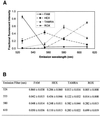Non-independence of Mnt repressor-operator interaction determined by a new quantitative multiple fluorescence relative affinity (QuMFRA) assay
- PMID: 11410653
- PMCID: PMC55749
- DOI: 10.1093/nar/29.12.2471
Non-independence of Mnt repressor-operator interaction determined by a new quantitative multiple fluorescence relative affinity (QuMFRA) assay
Abstract
Salmonella bacteriophage repressor Mnt belongs to the ribbon-helix-helix class of transcription factors. Previous SELEX results suggested that interactions of Mnt with positions 16 and 17 of the operator DNA are not independent. Using a newly developed high-throughput quantitative multiple fluorescence relative affinity (QuMFRA) assay, we directly quantified the relative equilibrium binding constants (K(ref)) of Mnt to operators carrying all the possible dinucleotide combinations at these two positions. Results show that Mnt prefers binding to C, instead of wild-type A, at position 16 when wild-type C at position 17 is changed to other bases. The measured K(ref) values of double mutants were also higher than the values predicted from single mutants, demonstrating the non-independence of these two positions. The ability to produce a large number of quantitative binding data simultaneously and the potential to scale up makes QuMFRA a valuable tool for the large-scale study of macromolecular interaction.
Figures




References
-
- Sauer R.T., Krovatin,W., DeAnda,J., Youderian,P. and Susskind,M.M. (1983) Primary structure of the immI immunity region of bacteriophage P22. J. Mol. Biol., 168, 699–713. - PubMed
-
- Raumann B.E., Rould,M.A., Pabo,C.O. and Sauer,R.T. (1994) DNA recognition by β-sheets in the Arc repressor–operator crystal structure. Nature, 367, 754–757. - PubMed
-
- Vershon A.K., Youderian,P., Susskind,M.M. and Sauer,R.T. (1985) The bacteriophage P22 arc and mnt repressors. Overproduction, purification and properties. J. Biol. Chem., 260, 12124–12129. - PubMed
-
- Vershon A.K., Liao,S.M., McClure,W.R. and Sauer,R.T. (1987) Bacteriophage P22 Mnt repressor. DNA binding and effects on transcription in vitro. J. Mol. Biol., 195, 311–322. - PubMed
-
- Knight K.L., Bowie,J.U., Vershon,A.K., Kelley,R.D. and Sauer,R.T. (1989) The Arc and Mnt repressors. A new class of sequence-specific DNA-binding protein. J. Biol. Chem., 264, 3639–3642. - PubMed
Publication types
MeSH terms
Substances
Grants and funding
LinkOut - more resources
Full Text Sources
Other Literature Sources

